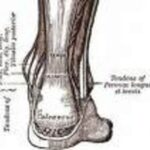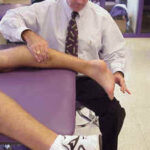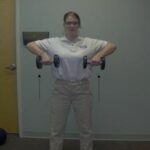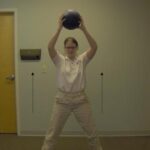Nobody resolves to come down with a case of Achilles tendonitis, but many who head to the gym each January in an attempt to keep their resolutions for better fitness do just that. Achilles tendonitis occurs when the band of tissues that connects the muscles in the back of the lower leg to the heel bone become inflamed or irritated, usually from a sudden increase in use. The Achilles tendon comes into play whenever you walk, run, jump, or try to push up on your toes, so anything that affects it adversely is something to be avoided. Achilles tendonitis can be treated rather easily, but if it is ignored, it can grow into a much worse problem, such as a rupture of the Achilles tendon.
When the Achilles tendon is put under duress too quickly, it can develop minute tears that cause inflammation. Someone who decides to get up and begin working out that has not been doing so is at risk, especially if they engage in endeavors that require repetitive activity, such as walking on a treadmill or using a stair climbing machine. Achilles tendonitis can develop as the muscles and tissues are not used to such rigorous repeated movements. Sports that involve frequent starts and stops, such as tennis, basketball, and racquetball, will precipitate Achilles tendonitis if the person is not properly conditioned for the motions. A lack of flexibility and strength in the calf muscles can contribute to this, as can trying to do too much right away. If you suffer from flattened arches, you could be a candidate to have Achilles tendonitis, since you place undue stress on the Achilles tendon with every step that you take. Achilles tendonitis can also be the result of some type of infection or trauma to the Achilles tendon.
Even athletes that have been participating in their sport for a while can come down with Achilles tendonitis; runners who add more hills to their weekly schedule for example. Changing the type of shoe or sneaker that you wear can precipitate Achilles tendonitis. As we age, our Achilles tendon loses flexibility and is more liable to be injured. Middle-aged athletes out for a little recreation are the ones likely to acquire Achilles tendonitis. The symptoms come on gradually, usually starting with an ache or pain as you push off of your foot while walking. It can hurt when you rise on your toes, and there will be tenderness over your Achilles tendon. The tendon will seem stiff until you warm up, and there could be some swelling in the region. There may even be a creaking sound heard when you move your Achilles tendon. Soreness in the morning when you first get up, and when you try to get going again after you have been at rest, are a couple of signs that you may have Achilles tendonitis. It will hurt less once you have been at it for a while, but then the pain will subside, only to increase with time as you remain active.
The worst thing you can do to your Achilles tendon is to rupture it completely or partially. You will know if you have done this by the sudden pain and subsequent swelling in the tendon. It may feel as if you have been kicked in the back of your ankle, and you will lose the capability of rising on your toes on that foot. X-rays or an MRI will confirm the damage in this case, and it will need to be surgically reattached. Three-quarters of Achilles heel ruptures occur to those playing basketball or tennis. If you only suffer from Achilles tendonitis, there are steps to take to get better. Rest is the first one, as the tissue gets a chance to heal as you refrain from the activity that caused the damage. You need not stop exercising completely, but you may want to switch gears so to speak and try low impact activities like riding the stationary bike until your Achilles tendonitis is gone.
Icing your Achilles tendon, doing so several times a day for twenty minutes at a time using an ice pack, can help to alleviate some of the discomfort and swelling. Be sure to keep the affected foot elevated at night to reduce swelling. Over-the-counter painkillers such as aspirin or Tylenol may take some of the bite out of the pain, but should not be a long term solution. If your Achilles tendon is still sore after you have tried these measures, see your doctor. You may need a temporary foot insert for your footwear that elevates your heel to relieve the strain on the tendon. Heel pads can cushion and support the area, and in severe cases of Achilles tendonitis, you may need even more support, such as crutches, or a special splint that stretches the tendon, for example.
To avoid Achilles tendonitis, it makes sense to start any exercise regimen gradually, allowing your body to build up. Always warm up first and start slowly, and realize that proper footwear is important. Your shoes should provide cushioning for your heel and support for your arches. Stretching your calf muscles and Achilles tendon before and after exercise will help them to stay flexible. If you are new to the gym, build up strength in your lower legs by doing toe raises. There are special machines for just this purpose that the staff will be happy to show you. Ask questions if you do not know how a particular machine will impact your body. Achilles tendonitis can be avoided in many cases, allowing you to get on with your resolution to get into shape.





